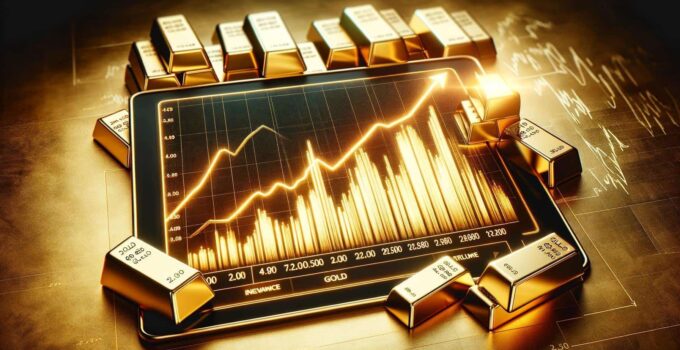Vangoldmining.com is a reader-supported site. We may earn a commission if you click links and make a purchase. This article is for informational purposes only, and does not constitute financial advice.
Curious about what factors determine the price of gold? Want to know how the history of gold prices has shaped the current trends in the market?
Interested in learning what experts are saying about the future of gold prices, including forecasts for the short, medium, and long term? Excited to explore the potential influences on gold prices in the future, from emerging technologies to geopolitical tensions?
Ready to discover strategies for investing in gold, including the risks and benefits involved?
If so, keep reading to uncover all this and more in our comprehensive guide on gold price forecast for 2050.
What Determines the Price of Gold?
The price of gold is influenced by a myriad of factors, including market trends, economic outlook, and future projections. As a precious metal, gold holds a unique position in the investment landscape, with its value subject to fluctuations based on various economic indicators and global economic conditions.
The demand for gold as a safe-haven asset during economic uncertainties tends to drive its prices up. In times of geopolitical tensions or financial instability, investors often flock to gold as a means to hedge against potential risks in other asset classes. Central bank policies, inflation rates, and currency movements play a crucial role in determining the price of gold. Understanding these intricacies is essential for investors looking to incorporate gold into their investment strategy.
The History of Gold Prices
Exploring the history of gold prices reveals a complex narrative of price fluctuations, influenced by various economic and market factors. By analyzing historical data and utilizing predictive modeling techniques, experts can gain insights into the patterns of gold price movement over time.
Through detailed data analysis, researchers have identified key trends in gold prices, showcasing periods of significant volatility alongside more stable stretches. These observations underscore the necessity of leveraging advanced forecasting techniques to anticipate future price behavior. By examining the correlation between historical events and price shifts, analysts can develop more informed strategies for navigating the unpredictable nature of the gold market.
The application of predictive modeling not only aids in understanding past movements but also serves as a valuable tool in formulating proactive measures to mitigate risks and capitalize on potential opportunities in the ever-evolving landscape of gold trading.
Factors That Have Affected Gold Prices in the Past
Throughout history, gold prices have been impacted by a multitude of factors, including macroeconomic conditions, market volatility, and key economic indicators. Understanding the interplay of these variables is crucial in predicting future gold price movements.
Factors like geopolitical tensions, inflation rates, and currency movements also play a significant role in influencing gold prices. For instance, during times of political uncertainty or when inflation rates are high, investors often turn to gold as a safe-haven asset, driving up its price.
Economic indicators such as GDP growth, interest rates, and consumer confidence can provide valuable insights into the health of the economy, further impacting gold prices. Market dynamics, such as supply and demand fluctuations, also contribute to the volatility of gold prices, making forecasting challenging yet essential for informed investment decisions.
Current Trends in the Gold Market
The current landscape of the gold market is characterized by evolving market trends, fluctuations in demand-supply dynamics, and the impact of key economic indicators on price movements. Analyzing these trends provides valuable insights for investors and analysts aiming to navigate the complexities of the gold market.
For instance, the increased global economic uncertainty has led to a surge in the demand for gold as a safe-haven asset, driving up prices in recent months. Geopolitical tensions and inflation concerns have further fueled investor interest in gold as a hedge against market volatility. Understanding these demand trends and their correlation with economic indicators such as interest rates and inflation rates is crucial for predicting future price movements and making informed investment decisions in the gold market.
Global Demand and Supply of Gold
The global demand and supply of gold play a pivotal role in determining its price trajectory in the market. As a precious metal and commodity, gold’s value is intricately linked to the interplay between demand dynamics and the available supply across different regions and economic sectors.
Economic indicators such as inflation rates, interest rates, and currency values also significantly impact the price of gold. For instance, when inflation rises, investors often turn to gold as a hedge against devaluation. Conversely, a strengthening currency may decrease the appeal of gold as an alternative investment. Understanding these economic indicators and their effects on gold prices is crucial for market participants looking to make informed decisions in the volatile commodity market environment.
Impact of Economic and Political Factors on Gold Prices
Economic and political factors wield significant influence over gold prices, with indicators such as inflation rates, monetary policy decisions, and economic outlooks shaping the market sentiment towards this precious metal. Understanding how these factors interact is vital for predicting future price movements.
Inflation rates play a pivotal role in determining the purchasing power of consumers and, consequently, influence the demand for gold as a hedge against inflation. When inflation rates are high, investors often seek the stability and value retention offered by gold.
Changes in monetary policy, such as interest rate adjustments by central banks, can impact the opportunity cost of holding gold, affecting its attractiveness as an investment.
Shifts in the economic outlook, including GDP growth forecasts and global economic conditions, can also sway investor sentiment towards gold as a safe haven asset.
What Do Experts Say About the Future of Gold Prices?
Expert opinions on the future of gold prices vary, with analysts providing diverse forecasts and projections based on historical data analysis, market research, and predictive modeling. These insights offer valuable perspectives for investors seeking to understand the potential trajectory of gold prices.
Some experts believe that global economic trends play a significant role in determining the direction of gold prices, while others emphasize geopolitical events and inflation rates as key factors influencing future projections.
By analyzing supply and demand dynamics, experts can gauge the market sentiment and predict potential price movements.
Advancements in technology have enabled analysts to use sophisticated algorithms and artificial intelligence in forecasting methodologies, enhancing the accuracy of their predictions.
Understanding these diverse viewpoints helps investors make informed decisions in managing their gold investments.
Forecasts for Gold Prices in the Short-term (1-5 years)
Short-term forecasts for gold prices encompass a range of possibilities, influenced by market speculation, economic growth projections, and geopolitical events. Analyzing these factors provides insights into the potential price movements in the near future.
Market speculation plays a significant role in shaping short-term outlooks for gold as traders interpret and react to economic data, global trends, and central bank policies. Economic growth indicators like GDP, employment rates, and inflation rates heavily impact investors’ sentiment towards gold, influencing its short-term price trajectory. In addition, unexpected geopolitical events such as trade disputes or political tensions can trigger sudden spikes or drops in gold prices, making it essential for traders to stay informed and agile in their decision-making strategies.
Forecasts for Gold Prices in the Medium-term (5-10 years)
Medium-term forecasts for gold prices involve considerations of speculative investments, wealth accumulation strategies, and economic indicators that could impact the price trajectory over the next 5-10 years. These forecasts offer insights for investors with a longer investment horizon.
Understanding the underlying factors driving gold prices is essential for investors seeking to capitalize on potential opportunities within the market. Speculative investment trends play a significant role in shaping the demand for gold, influencing price movements.
Analyzing economic indicators such as inflation rates, geopolitical events, and currency fluctuations can provide valuable clues for predicting the medium-term outlook for gold. By strategically aligning wealth accumulation strategies with these forecasts, investors can position themselves advantageously in the ever-evolving landscape of the precious metals market.
Forecasts for Gold Prices in the Long-term (10+ years)
Long-term forecasts for gold prices extend beyond a decade, focusing on factors such as capital appreciation potential, retirement planning considerations, and asset protection strategies. These forecasts offer insights into the role of gold as a long-term investment asset.
Gold has historically been considered a safe haven asset, particularly in times of economic uncertainty, making it a valuable addition to a diversified investment portfolio. When looking at capital appreciation opportunities, the price of gold tends to move inversely to other assets like stocks, providing a hedge against market risks.
For retirement planning, holding gold can act as a form of wealth preservation, safeguarding purchasing power over the long term. In terms of asset protection strategies, gold’s physical presence offers a tangible store of value that is independent of currency fluctuations. Amid fluctuating economic conditions, gold’s enduring value makes it an attractive option for long-term investors seeking stability and security.
Factors That Could Influence Gold Prices in the Future
The future price of gold is subject to a range of influencing factors, including emerging technologies, economic uncertainties, and fluctuations in interest rates. Understanding these dynamics is crucial for investors seeking to anticipate gold price movements.
Technological advancements play a significant role in shaping the future landscape of gold prices. Innovations in mining techniques, such as automation and AI integration, can impact supply levels and production costs, ultimately affecting the market. Economic uncertainty, fueled by global events like trade disputes and geopolitical tensions, adds volatility to the precious metal’s value. Shifts in central bank policies and interest rates can directly impact gold prices as investors assess alternative assets amid changing financial conditions.
Emerging Technologies and Their Impact on Gold Demand
Emerging technologies play a pivotal role in shaping the demand for gold, with advancements in data analytics and future value estimations influencing investor perceptions of this precious metal. Understanding the intersection of technology and gold markets is essential for anticipating future demand trends.
Technological advancements have led to a more data-driven approach in assessing the value of gold, providing investors with greater insight into market dynamics. Data analytics tools enable the extraction of valuable insights from vast amounts of market data, helping to forecast demand patterns more accurately. The integration of artificial intelligence in market analysis has revolutionized how stakeholders interpret and respond to changing market sentiments. By leveraging these technological tools, investors can make informed decisions and navigate the complexities of the gold market with confidence.
Changes in Global Economy and Trade
Changes in the global economy and trade scenarios have profound implications for gold prices, with currency fluctuations and statistical analysis playing a crucial role in determining the value of gold in international markets. Monitoring these economic shifts is essential for anticipating future price movements.
In recent years, the interconnectedness of global markets has intensified, leading to increased volatility in gold prices. As countries engage in trade agreements or disputes, investors closely watch for any potential impact on currency values, which in turn influences the attractiveness of gold as a safe-haven asset.
Understanding how different currencies fluctuate against one another provides valuable insight into the intricate relationships within the global economy. Through employing sophisticated statistical models and historical data analysis, experts aim to predict possible trends in gold prices, aiding both traders and policymakers in making informed decisions.
Geopolitical Tensions and Their Effect on Gold Prices
Geopolitical tensions often have a significant impact on gold prices, with market reactions influenced by stock market performance and in-depth market analysis. Understanding the connection between geopolitical events and gold price fluctuations is vital for investors navigating volatile market conditions.
When geopolitical tensions rise, investors tend to seek safe-haven assets like gold, driving up its price. This relationship between geopolitical factors and gold prices is complex and requires a nuanced understanding of global dynamics.
Stock market performance plays a crucial role as well, as it can indicate investor sentiment and risk appetite, impacting the demand for gold. Market analysis that takes into consideration geopolitical events can provide valuable insights into potential price movements and investment strategies.
Strategies for Investing in Gold
Developing effective strategies for investing in gold involves considerations of investment horizons, risk management techniques, and the role of gold in portfolio diversification. Crafting a well-rounded investment plan is essential for leveraging the potential of gold as a wealth preservation asset.
Understanding the market forces that influence gold prices and staying informed about geopolitical events impacting its value are crucial aspects of successful gold investment strategies.
Incorporating both physical gold and gold-related financial instruments can provide a balanced approach to portfolio diversification.
Implementing stop-loss orders and regularly reviewing investment performance are key risk management practices to safeguard your gold investments from unforeseen downturns in the market.
Short-term vs Long-term Investment in Gold
Deciding between short-term and long-term investment strategies for gold necessitates an evaluation of market volatility, alternative investment options, and individual risk preferences. Balancing short-term gains with long-term growth potential is key to optimizing one’s investment portfolio.
For investors seeking short-term gains, the fluctuating nature of the gold market due to factors like economic indicators and geopolitical events can present both opportunities and risks. In contrast, those espousing a long-term approach may benefit from the potential stability of gold as a hedge against inflation and currency devaluation over an extended investment horizon.
Exploring alternative investment avenues such as gold-backed exchange-traded funds (ETFs) or mining stocks can offer diversification benefits to mitigate market volatility and enhance overall portfolio resilience.
Diversifying Your Portfolio with Gold
Diversifying your investment portfolio with gold involves strategic asset allocation, prudent wealth management practices, and a forward-looking economic forecasting outlook. Incorporating gold into a diversified portfolio can enhance risk management and wealth preservation strategies.
Gold’s historical stability provides a hedge against inflation and currency devaluation, adding a valuable diversification element to a portfolio. Gold has shown a negative correlation with other traditional assets like stocks, bonds, and real estate, which can help reduce overall portfolio volatility. This not only can improve risk-adjusted returns but also offer protection during market downturns. Wealth managers often include gold as a defensive asset to balance the overall risk exposure and aim for more consistent long-term growth.
Potential Risks and Benefits of Investing in Gold
Investing in gold offers a blend of potential risks and benefits, encompassing asset protection advantages, insights from market research, and the utility of financial modeling in decision-making processes. Evaluating these aspects is crucial for informed investment decisions in the gold market.
Gold’s intrinsic value has made it a traditional safe-haven asset, serving as a hedge against economic uncertainties. Through market research, investors gain valuable insights into the trends influencing gold prices, helping them make strategic investment choices.
Financial modeling, on the other hand, enables investors to forecast potential returns, evaluate risk factors, and optimize their gold investment portfolios. Balancing the risks and benefits of gold investment with a well-informed approach fosters resilience and diversification within one’s asset protection strategy.
Frequently Asked Questions
What is the projected gold price forecast for 2050?
According to our reference data, there is no specific forecast for gold prices in 2050.
Will the gold price increase or decrease in 2050?
The prediction for gold prices in 2050 is uncertain, as it is influenced by various economic and political factors.
How can I make a gold price forecast for 2050?
Making a precise gold price forecast for 2050 is difficult, but you can analyze current market trends and historical data to make a rough estimate.
What factors will affect the gold price in 2050?
The gold price in 2050 may be influenced by global economic conditions, inflation rates, interest rates, and political stability.
Is investing in gold a good option for the future?
While gold is considered a safe-haven asset, its long-term price performance is uncertain. It is advisable to consult a financial advisor before making any investment decisions.
How can I stay updated on gold price forecasts for 2050?
You can monitor market news and consult with financial experts to stay updated on the latest forecasts for gold prices in 2050.




